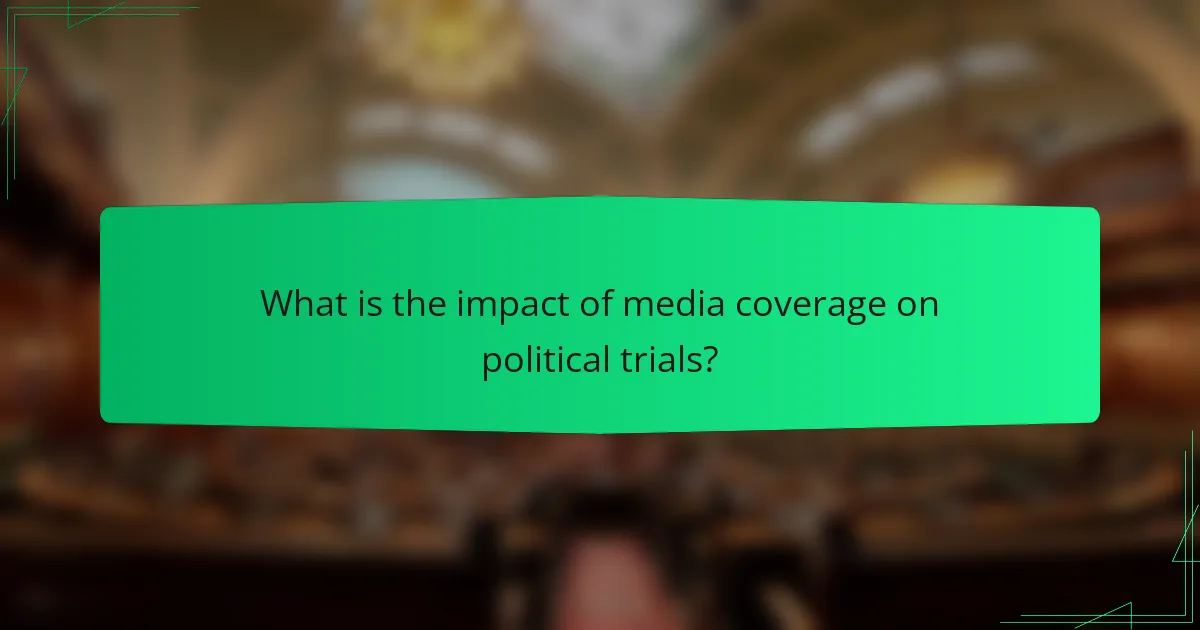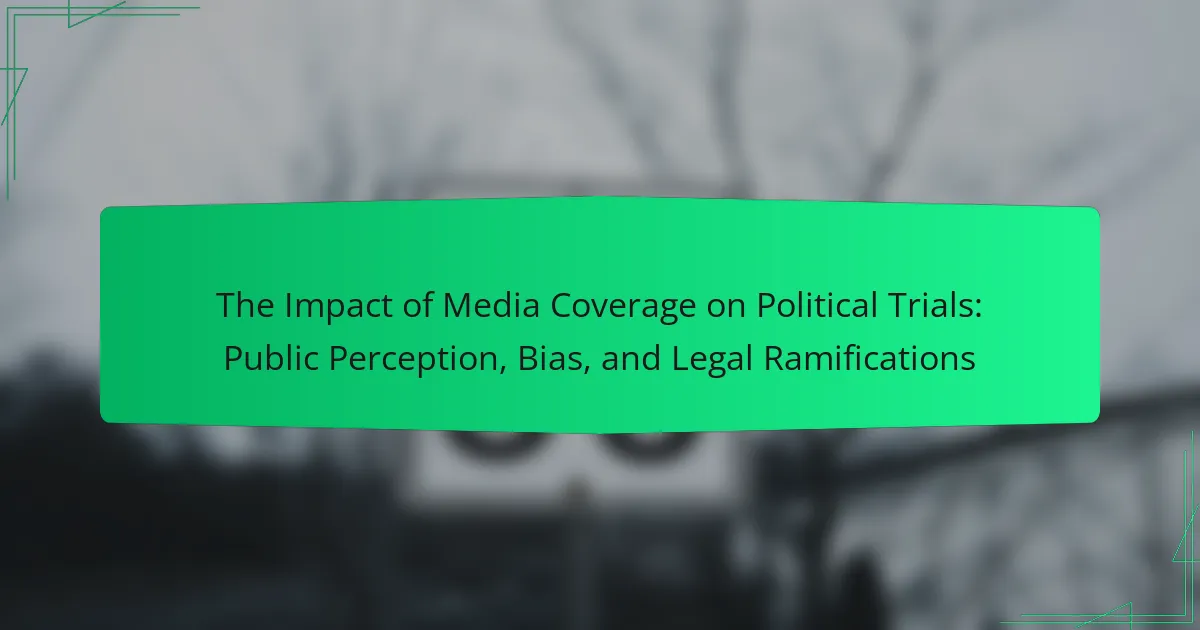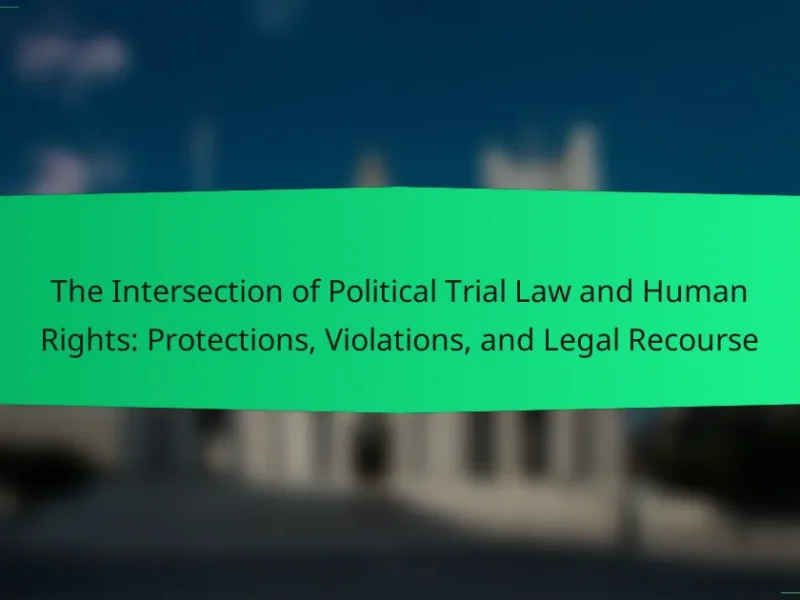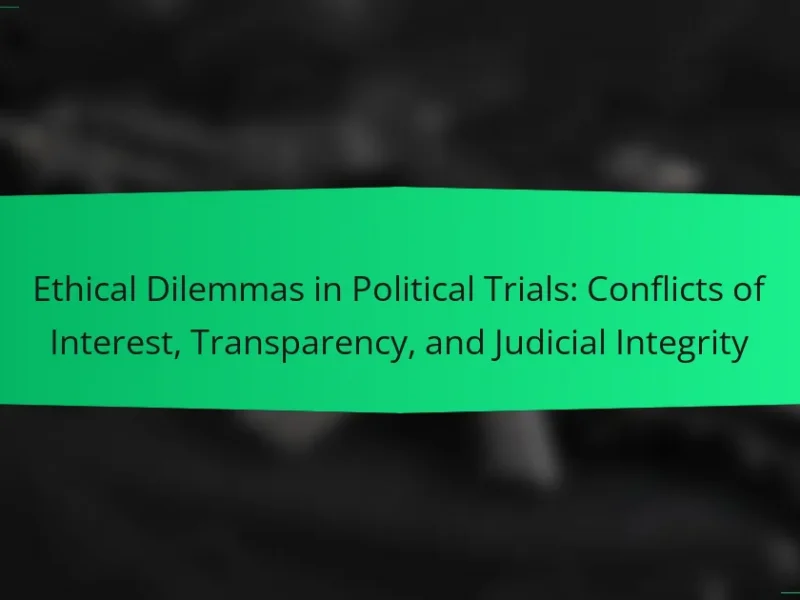Media coverage is a significant entity that influences political trials by shaping public perception and swaying opinions prior to verdicts. Extensive media attention can lead to heightened public interest and scrutiny, which in turn pressures legal systems to operate more transparently. The narratives constructed by media can create biases against defendants or plaintiffs, potentially impacting juror impartiality and trial outcomes. Furthermore, attorneys may adjust their legal strategies based on the public sentiment driven by media coverage. Historical cases, such as the O.J. Simpson trial, exemplify how media narratives dominate public opinion and affect the judicial process. This article explores the multifaceted impact of media coverage on political trials, focusing on its effects on perceptions, biases, and legal ramifications.

What is the impact of media coverage on political trials?
Media coverage significantly influences political trials. It shapes public perception and can sway opinions before a verdict is reached. Extensive media attention often leads to increased public interest and scrutiny. This scrutiny can pressure legal systems to act more transparently.
Moreover, media narratives can create biases against defendants or plaintiffs. For instance, sensational reporting may lead to preconceived notions of guilt or innocence. This bias can affect juror impartiality and trial outcomes.
Additionally, media coverage can impact legal strategies employed by attorneys. Lawyers may adjust their tactics based on public sentiment shaped by the media. Historical examples, such as the trial of O.J. Simpson, illustrate how media coverage can dominate the narrative and influence public opinion.
In conclusion, media coverage plays a crucial role in shaping the dynamics of political trials. It affects perceptions, biases, and legal strategies involved in the judicial process.
How does media coverage shape public perception of political trials?
Media coverage significantly shapes public perception of political trials. The framing of information influences how the public interprets events. Sensational headlines can create biases, leading to polarized opinions. Coverage often highlights specific aspects, such as the defendant’s background or trial irregularities. This selective emphasis can skew public understanding. Studies show that extensive media attention correlates with heightened public interest and opinion formation. For instance, a 2019 study by the Pew Research Center found that 64% of Americans believe media coverage affects trial outcomes. Therefore, the way media presents political trials directly impacts public perception and opinion.
What role does sensationalism play in media coverage of political trials?
Sensationalism significantly influences media coverage of political trials. It often prioritizes dramatic narratives over factual reporting. This approach can heighten public interest and engagement. Sensationalized stories may distort the perception of legal proceedings. For instance, headlines may exaggerate aspects of the trial to attract viewers. Research shows that sensationalism can lead to biased public opinions. A study by the Pew Research Center found that sensational headlines affect audience perceptions of guilt. This manipulation can undermine the integrity of the judicial process. Ultimately, sensationalism shapes how political trials are viewed by the public.
How do different media formats influence public opinion on political trials?
Different media formats significantly influence public opinion on political trials. Television broadcasts often provide visual and emotional engagement, shaping perceptions through imagery and sound. Social media platforms facilitate rapid information dissemination, allowing for diverse viewpoints to emerge quickly. Print media, such as newspapers, typically offer in-depth analysis and context, impacting public understanding over time. Research indicates that sensationalist coverage can lead to biased perceptions, as seen in the coverage of high-profile trials like the O.J. Simpson case. Studies show that audience engagement varies by format, with younger demographics gravitating towards social media for updates. This shift can create echo chambers, reinforcing existing beliefs. Overall, the format of media coverage plays a crucial role in shaping public opinion during political trials.
What biases are present in media coverage of political trials?
Media coverage of political trials often exhibits several biases. One common bias is partisan bias, where media outlets favor one political side over another. This can lead to skewed reporting that emphasizes negative aspects of one party while downplaying or ignoring similar issues in another. Confirmation bias is also prevalent, where journalists select information that supports their existing beliefs. Sensationalism is another bias, as media often prioritize dramatic narratives over factual reporting to attract viewership. Furthermore, framing bias occurs when the media presents information in a way that influences audience interpretation. Research indicates that these biases can shape public perception significantly, affecting how political trials are understood and discussed.
How do political affiliations of media outlets affect their coverage of trials?
Political affiliations of media outlets significantly influence their coverage of trials. Outlets with conservative affiliations may emphasize themes of law and order, portraying defendants in a harsher light. Conversely, liberal outlets might focus on social justice aspects, advocating for the rights of defendants. Research indicates that partisan media can shape public perception by framing trial narratives differently. For example, a study by the Pew Research Center found that audiences often receive skewed information based on the political leanings of their preferred news sources. This results in polarized views on legal proceedings. Ultimately, the political stance of a media outlet can lead to biased reporting, affecting public understanding and opinion regarding trials.
What are the implications of biased reporting on public trust in the judicial system?
Biased reporting significantly undermines public trust in the judicial system. It creates a distorted perception of legal proceedings. When media outlets present selective information, they influence public opinion. This can lead to misinformed beliefs about the fairness of trials. Studies indicate that sensationalized coverage correlates with decreased confidence in legal institutions. For example, a 2020 survey found that 65% of respondents felt media bias affected their views on court decisions. Consequently, biased reporting can erode the legitimacy of the judicial system in the eyes of the public.
What are the legal ramifications of media coverage on political trials?
Media coverage of political trials can lead to significant legal ramifications. It may influence the impartiality of jurors, potentially violating the defendant’s right to a fair trial. Pre-trial publicity can result in changes to trial locations or jury selection processes. Courts may impose gag orders to limit media reporting and protect trial integrity. Excessive media coverage can also lead to public bias against defendants, impacting judicial outcomes. In some cases, media coverage has prompted appeals based on claims of prejudicial influence. The Supreme Court has addressed these issues, emphasizing the balance between free press and fair trial rights. For instance, in Sheppard v. Maxwell (1966), the Court ruled that media coverage can infringe on a defendant’s right to a fair trial.
How can media coverage affect the outcome of a political trial?
Media coverage can significantly influence the outcome of a political trial by shaping public perception. Extensive media attention can lead to heightened public interest and scrutiny. This scrutiny may pressure judges and juries to consider public opinion in their decisions. Additionally, media narratives can create biases that affect how legal arguments are perceived. For instance, if the media portrays a defendant negatively, it may sway public sentiment against them. Studies have shown that pre-trial publicity can lead to biased juror opinions. In high-profile cases, media framing often dictates the narrative surrounding the trial. Ultimately, the interplay between media coverage and public perception can impact legal outcomes.
What legal protections exist for defendants against prejudicial media coverage?
Defendants have several legal protections against prejudicial media coverage. One key protection is the right to a fair trial under the Sixth Amendment. This amendment ensures that defendants can contest the influence of media on their case. Courts can impose gag orders to limit what parties can say publicly. Such orders aim to minimize pretrial publicity. Additionally, judges may change the trial venue to reduce local bias. This change helps ensure an impartial jury. Another protection is the ability to request jury instructions. These instructions can remind jurors to disregard media coverage. Legal precedents, such as Sheppard v. Maxwell, underscore the importance of these protections. In that case, the Supreme Court ruled that excessive media coverage can violate a defendant’s rights.
How can media coverage impact the jury selection process in political trials?
Media coverage can significantly influence the jury selection process in political trials. High-profile cases often attract extensive media attention. This coverage can shape public perception of the defendant and the trial itself. Potential jurors may be exposed to biased or sensationalized information. Such exposure can lead to preconceived notions about the case. Consequently, jurors may enter the courtroom with biases that affect their impartiality. Research indicates that jurors influenced by media coverage may struggle to remain unbiased. For example, a study from the American Bar Association found that jurors can be swayed by pretrial publicity. This underscores the need for careful jury selection processes to mitigate media influence.
What strategies are used to mitigate media influence during jury selection?
Strategies to mitigate media influence during jury selection include extensive voir dire processes. Judges conduct thorough questioning to identify potential biases. They may also limit media exposure for jurors through sequestration. This prevents jurors from being influenced by external information. Another strategy involves providing jurors with specific instructions on avoiding media. Courts may also use anonymous juries to protect identities and reduce outside pressure. Research indicates that these methods help maintain fair trial standards. For example, studies show that sequestered juries are less affected by media coverage.
How does pre-trial publicity affect potential jurors’ perceptions?
Pre-trial publicity significantly influences potential jurors’ perceptions. High levels of media coverage can create preconceived notions about a case. This can lead to bias, as jurors may form opinions before hearing evidence. Studies show that jurors exposed to negative publicity are more likely to view the defendant unfavorably. Research indicates that 70% of jurors are affected by pre-trial media coverage. Jurors often struggle to remain impartial due to the information they have encountered. This can undermine the fairness of the trial process. Ultimately, pre-trial publicity can compromise the integrity of the judicial system.
What best practices should media follow when covering political trials?
Media should adhere to several best practices when covering political trials. First, they must ensure accuracy in reporting. Factual errors can mislead the public and affect perceptions. Second, media should avoid sensationalism. Exaggerated narratives can distort the truth and inflame public opinion. Third, they must provide balanced coverage. Presenting multiple viewpoints fosters a more informed audience. Fourth, media should respect the legal process. Reporting on ongoing trials requires sensitivity to avoid prejudicing the outcome. Fifth, they should prioritize transparency. Disclosing sources and methods builds trust with the audience. Lastly, media should adhere to ethical guidelines. Organizations like the Society of Professional Journalists provide standards for responsible reporting. These practices help maintain public trust and uphold the integrity of the judicial system.
How can media outlets ensure balanced and fair reporting on political trials?
Media outlets can ensure balanced and fair reporting on political trials by adhering to strict journalistic standards. They should verify facts through multiple reliable sources before publication. This practice helps mitigate bias and misinformation. Outlets must present diverse perspectives, including those of the defense and prosecution. This approach fosters a more comprehensive understanding of the trial. Additionally, employing impartial language is crucial to avoid influencing public perception. Media organizations should also provide context about the legal processes involved. This context aids the audience in grasping the complexities of political trials. Regular training on ethical reporting can enhance journalists’ skills in maintaining balance.
What ethical considerations should journalists keep in mind during political trial coverage?
Journalists should prioritize accuracy, fairness, and impartiality during political trial coverage. They must verify facts before reporting to prevent misinformation. Ensuring balanced representation of all parties involved is essential. Journalists should avoid conflicts of interest that could compromise their integrity. Respecting the presumption of innocence is crucial until a verdict is reached. Sensationalism should be avoided to maintain public trust. Ethical guidelines from organizations like the Society of Professional Journalists provide a framework for responsible reporting. Adhering to these principles helps uphold the credibility of journalism in politically sensitive contexts.
The main entity of the article is media coverage in relation to political trials. The article examines how media coverage shapes public perception, creates biases, and influences legal strategies within the context of political trials. It highlights the impact of sensationalism, the role of different media formats, and the implications of biased reporting on public trust in the judicial system. Additionally, it addresses the legal ramifications of media influence on jury selection and trial outcomes, while also providing best practices for ethical media reporting. Overall, the article underscores the significant role media plays in the dynamics of political trials.


